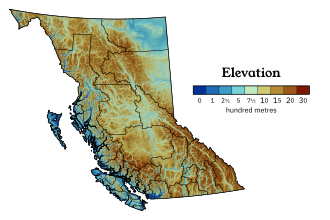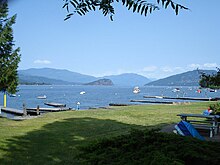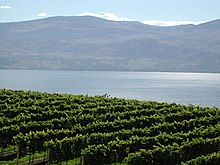
A | B | C | D | E | F | G | H | CH | I | J | K | L | M | N | O | P | Q | R | S | T | U | V | W | X | Y | Z | 0 | 1 | 2 | 3 | 4 | 5 | 6 | 7 | 8 | 9
British Columbia
| |
|---|---|
Province | |
| Motto: Splendor sine occasu (Latin for 'splendour without diminishment') | |
| Coordinates: 54°N 125°W / 54°N 125°W[4] | |
| Country | Canada |
| Before confederation | United Colony of British Columbia |
| Confederation | July 20, 1871 (7th) |
| Capital | Victoria |
| Largest city | Vancouver |
| Largest metro | Greater Vancouver |
| Government | |
| • Type | Parliamentary constitutional monarchy |
| • Lieutenant governor | Janet Austin |
| • Premier | David Eby |
| Legislature | Legislative Assembly of British Columbia |
| Federal representation | Parliament of Canada |
| House seats | 42 of 338 (12.4%) |
| Senate seats | 6 of 105 (5.7%) |
| Area | |
| • Total | 944,735 km2 (364,764 sq mi) |
| • Land | 925,186 km2 (357,216 sq mi) |
| • Water | 19,548.9 km2 (7,547.9 sq mi) 2.1% |
| • Rank | 5th |
| 9.5% of Canada | |
| Population (2021) | |
| • Total | 5,000,879[5] |
| • Estimate (Q1 2024) | 5,609,870[6] |
| • Rank | 3rd |
| • Density | 5.41/km2 (14.0/sq mi) |
| Demonym | British Columbian[a] |
| Official languages | English (de facto) |
| GDP | |
| • Rank | 4th |
| • Total (2015) | CA$249.981 billion[7] |
| • Per capita | CA$53,267 (8th) |
| HDI | |
| • HDI (2021) | 0.944[8] — Very high (2nd) |
| Time zones | |
| Most of province[b] | UTC−08:00 (Pacific) |
| • Summer (DST) | UTC−07:00 (Pacific DST) |
| Southeastern | UTC−07:00 (Mountain) |
| • Summer (DST) | UTC−06:00 (Mountain DST) |
| Eastern | UTC−07:00 (Mountain ) |
| Canadian postal abbr. | BC |
| Postal code prefix | |
| ISO 3166 code | CA-BC |
| Flower | Pacific dogwood |
| Tree | Western red cedar |
| Bird | Steller's jay |
| Rankings include all provinces and territories | |
British Columbia (commonly abbreviated as BC) is the westernmost province of Canada. Situated between the Pacific Ocean and the Rocky Mountains, the province has a diverse geography, with rugged landscapes that include rocky coastlines, sandy beaches, forests, lakes, mountains, inland deserts and grassy plains.[9] British Columbia borders the province of Alberta to the east; the territories of Yukon and Northwest Territories to the north; the U.S. states of Washington, Idaho and Montana to the south, and Alaska to the northwest. With an estimated population of over 5.6 million as of 2024, it is Canada's third-most populous province. The capital of British Columbia is Victoria, while the province's largest city is Vancouver. Vancouver and its suburbs together make up the third-largest metropolitan area in Canada, with the 2021 census recording 2.6 million people in Metro Vancouver.[10]
The first known human inhabitants of the area settled in British Columbia at least 10,000 years ago. Such groups include the Coast Salish, Tsilhqotʼin, and Haida peoples, among many others. One of the earliest British settlements in the area was Fort Victoria, established in 1843, which gave rise to the city of Victoria, the capital of the Colony of Vancouver Island. The Colony of British Columbia (1858–1866) was subsequently founded by Richard Clement Moody,[11] and by the Royal Engineers, Columbia Detachment, in response to the Fraser Canyon Gold Rush. Moody selected the site for and founded the mainland colony's capital New Westminster.[12][13][14] The colonies of Vancouver Island and British Columbia were incorporated in 1866, subsequent to which Victoria became the united colony's capital. In 1871, British Columbia entered Confederation as the sixth province of Canada, in enactment of the British Columbia Terms of Union.
British Columbia is a diverse and cosmopolitan province, drawing on a plethora of cultural influences from its British Canadian, European, and Asian diasporas, as well as the Indigenous population. Though the province's ethnic majority originates from the British Isles, many British Columbians also trace their ancestors to continental Europe, East Asia, and South Asia.[15] Indigenous Canadians constitute about 6 percent of the province's total population.[16] Christianity is the largest religion in the region, though the majority of the population is non-religious.[17][18] English is the common language of the province, although Punjabi, Mandarin Chinese, and Cantonese also have a large presence in the Metro Vancouver region. The Franco-Columbian community is an officially recognized linguistic minority, and around one percent of British Columbians claim French as their mother tongue.[19] British Columbia is home to at least 34 distinct Indigenous languages.[20]
Major sectors of British Columbia's economy include forestry, mining, filmmaking and video production, tourism, real estate, construction, wholesale, and retail. Its main exports include lumber and timber, pulp and paper products, copper, coal, and natural gas.[21] British Columbia exhibits high property values and is a significant centre for maritime trade:[22] the Port of Vancouver is the largest port in Canada and the most diversified port in North America.[23] Although less than 5 percent of the province's territory is arable land, significant agriculture exists in the Fraser Valley and Okanagan due to the warmer climate.[24] British Columbia is home to 45% of all publicly listed companies in Canada.[25]
Origin of the name
The province's name was chosen by Queen Victoria, when the Colony of British Columbia (1858–1866), i.e., "the Mainland", became a British colony in 1858.[26] It refers to the Columbia District, the British name for the territory drained by the Columbia River, in southeastern British Columbia, which was the namesake of the pre-Oregon Treaty Columbia Department of the Hudson's Bay Company. Queen Victoria chose British Columbia to distinguish what was the British sector of the Columbia District from the United States' ("American Columbia" or "Southern Columbia"), which became the Oregon Territory on August 8, 1848, as a result of the treaty.[27]
Ultimately, the Columbia in the name British Columbia is derived from the name of the Columbia Rediviva, an American ship which lent its name to the Columbia River and later the wider region;[28] the Columbia in the name Columbia Rediviva came from the name Columbia for the New World or parts thereof, a reference to Christopher Columbus.
The governments of Canada and British Columbia recognize Colombie-Britannique as the French name for the province.[29][30]
Geography

British Columbia is bordered to the west by the Pacific Ocean and the American state of Alaska, to the north by Yukon and the Northwest Territories, to the east by the province of Alberta, and to the south by the American states of Washington, Idaho, and Montana. The southern border of British Columbia was established by the 1846 Oregon Treaty, although its history is tied with lands as far south as California. British Columbia's land area is 944,735 square kilometres (364,800 sq mi). British Columbia's rugged coastline stretches for more than 27,000 kilometres (17,000 mi), and includes deep, mountainous fjords and about 6,000 islands, most of which are uninhabited. It is the only province in Canada that borders the Pacific Ocean.
British Columbia's capital is Victoria, located at the southeastern tip of Vancouver Island. Only a narrow strip of Vancouver Island, from Campbell River to Victoria, is significantly populated. Much of the western part of Vancouver Island and the rest of the coast is covered by temperate rainforest.
The province's most populous city is Vancouver, which is at the confluence of the Fraser River and Georgia Strait, in the mainland's southwest corner (an area often called the Lower Mainland). By land area, Abbotsford is the largest city. Vanderhoof is near the geographic centre of the province.[31]

The Coast Mountains and the Inside Passage's many inlets provide some of British Columbia's renowned and spectacular scenery, which forms the backdrop and context for a growing outdoor adventure and ecotourism industry. 75 percent of the province is mountainous (more than 1,000 m above sea level); 60 percent is forested; and only about 5 percent is arable.
The province's mainland away from the coastal regions is somewhat moderated by the Pacific Ocean. Terrain ranges from dry inland forests and semi-arid valleys, to the range and canyon districts of the Central and Southern Interior, to boreal forest and subarctic prairie in the Northern Interior. High mountain regions both north and south have subalpine flora[32] and subalpine climate.
The Okanagan wine area, extending from Vernon to Osoyoos at the United States border, is one of several wine and cider-producing regions in Canada. Other wine regions in British Columbia include the Cowichan Valley on Vancouver Island and the Fraser Valley.
The Southern Interior cities of Kamloops and Penticton have some of the warmest and longest summer climates in Canada (while higher elevations are cold and snowy), although their temperatures are often exceeded north of the Fraser Canyon, close to the confluence of the Fraser and Thompson rivers, where the terrain is rugged and covered with desert-type flora. Semi-desert grassland is found in large areas of the Interior Plateau, with land uses ranging from ranching at lower altitudes to forestry at higher ones.
The northern, mostly mountainous, two-thirds of the province is largely unpopulated and undeveloped, except for the area east of the Rockies, where the Peace River Country contains BC's portion of the Canadian Prairies, centred at the city of Dawson Creek.
British Columbia is considered part of the Pacific Northwest and the Cascadia bioregion, along with the American states of Alaska, Idaho, (western) Montana, Oregon, Washington, and (northern) California.[33][34]
Climate


Because of the many mountain ranges and rugged coastline, British Columbia's climate varies dramatically across the province.
Coastal southern British Columbia has a mild and rainy climate influenced by the North Pacific Current. Most of the region is classified as oceanic, though pockets of warm-summer Mediterranean climate also exist in the far-southern parts of the coast. Precipitation averages above 1,000 mm (39 in) in almost all of the coastal region, and Hucuktlis Lake on Vancouver Island receives an average of 6,903 mm (271.8 in) of rain annually.
Due to the blocking presence of successive mountain ranges, the climate of some of the interior valleys of the province (such as the Thompson, parts of the Fraser Canyon, the southern Cariboo and parts of the Okanagan) is semi-arid with certain locations receiving less than 250 millimetres (10 in) in annual precipitation. The annual mean temperature in the most populated areas of the province is up to 12 °C (54 °F), the mildest anywhere in Canada.
The valleys of the Southern Interior have short winters with only brief bouts of cold or infrequent heavy snow, while those in the Cariboo, in the Central Interior, are colder because of increased altitude and latitude, but without the intensity or duration experienced at similar latitudes elsewhere in Canada. Outside of the driest valleys, the Southern and Central Interior generally have a humid continental climate with widely variable precipitation. For example, the average daily low in Prince George (roughly in the middle of the province) in January is −12 °C (10 °F).[35] Small towns in the southern interior with high elevation such as Princeton are typically colder and snowier than cities in the valleys.[36]
Heavy snowfall occurs in all elevated mountainous terrain providing bases for skiers in both south and central British Columbia. Annual snowfall on highway mountain passes in the southern interior rivals some of the snowiest cities in Canada,[37] and freezing rain and fog are sometimes present on such roads as well.[38] This can result in hazardous driving conditions, as people are usually travelling between warmer areas such as Vancouver or Kamloops, and may be unaware that the conditions may be slippery and cold.[39]

Winters are generally severe in the Northern Interior which is generally in the subarctic climate zone, but even there, milder air can penetrate far inland. The coldest temperature in British Columbia was recorded in Smith River, where it dropped to −58.9 °C (−74.0 °F) on January 31, 1947,[40] one of the coldest readings recorded anywhere in North America. Atlin in the province's far northwest, along with the adjoining Southern Lakes region of Yukon, get midwinter thaws caused by the Chinook effect, which is also common (and much warmer) in more southerly parts of the Interior.
During winter on the coast, rainfall, sometimes relentless heavy rain, dominates because of consistent barrages of cyclonic low-pressure systems from the North Pacific. Average snowfall on the coast during a normal winter is between 25 and 50 centimetres (10 and 20 in), but on occasion (and not every winter) heavy snowfalls with more than 20 centimetres (8 in) and well below freezing temperatures arrive when modified arctic air reaches coastal areas, typically for short periods, and can take temperatures below −10 °C (14 °F), even at sea level. Arctic outflow winds can occasionally result in wind chill temperatures at or even below −17.8 °C (0.0 °F).[citation needed] While winters are very wet, coastal areas are generally milder and dry during summer under the influence of stable anti-cyclonic high pressure.
Southern Interior valleys are hot in summer; for example, in Osoyoos, the July maximum temperature averages 31.7 °C (89.1 °F), making it the hottest month of any location in Canada; this hot weather sometimes spreads towards the coast or to the far north of the province. Temperatures often exceed 40 °C (104 °F) in the lower elevations of valleys in the Interior during mid-summer, with the record high of 49.6 °C (121.3 °F) being held in Lytton on June 29, 2021, during a record-breaking heat wave that year.[41]

The extended summer dryness often creates conditions that spark forest fires, from dry-lightning or man-made causes. Many areas of the province are often covered by a blanket of heavy cloud and low fog during the winter months, in contrast to abundant summer sunshine. Annual sunshine hours vary from 2200 near Cranbrook and Victoria to less than 1300 in Prince Rupert, on the North Coast just south of Southeast Alaska.
The exception to British Columbia's wet and cloudy winters is during the El Niño phase. During El Niño events, the jet stream is much farther south across North America, making the province's winters milder and drier than normal. Winters are much wetter and cooler during the opposite phase, La Niña.
| Municipality | January | April | July | October | ||||
|---|---|---|---|---|---|---|---|---|
| Max | Min | Max | Min | Max | Min | Max | Min | |
| Prince Rupert | 5.6 °C (42.1 °F) | −0.8 °C (30.6 °F) | 10.2 °C (50.4 °F) | 2.5 °C (36.5 °F) | 16.2 °C (61.2 °F) | 10.5 °C (50.9 °F) | 11.1 °C (52.0 °F) | 4.9 °C (40.8 °F) |
| Tofino | 8.3 °C (46.9 °F) | 2.3 °C (36.1 °F) | 11.9 °C (53.4 °F) | 4.0 °C (39.2 °F) | 18.9 °C (66.0 °F) | 10.5 °C (50.9 °F) | 13.6 °C (56.5 °F) | 6.3 °C (43.3 °F) |
| Nanaimo | 6.9 °C (44.4 °F) | 0.1 °C (32.2 °F) | 14.1 °C (57.4 °F) | 3.9 °C (39.0 °F) | 23.9 °C (75.0 °F) | 12.3 °C (54.1 °F) | 14.6 °C (58.3 °F) | 5.2 °C (41.4 °F) |
| Victoria | 7.6 °C (45.7 °F) | 1.5 °C (34.7 °F) | 13.6 °C (56.5 °F) | 4.3 °C (39.7 °F) | 22.4 °C (72.3 °F) | 11.3 °C (52.3 °F) | 14.2 °C (57.6 °F) | 5.7 °C (42.3 °F) |
| Vancouver | 6.9 °C (44.4 °F) | 1.4 °C (34.5 °F) | 13.2 °C (55.8 °F) | 5.6 °C (42.1 °F) | 22.2 °C (72.0 °F) | 13.7 °C (56.7 °F) | 13.5 °C (56.3 °F) | 7.0 °C (44.6 °F) |
| Chilliwack | 6.1 °C (43.0 °F) | 0.4 °C (32.7 °F) | 15.8 °C (60.4 °F) | 5.2 °C (41.4 °F) | 25.0 °C (77.0 °F) | 12.5 °C (54.5 °F) | 15.3 °C (59.5 °F) | 6.4 °C (43.5 °F) |
| Penticton | 1.8 °C (35.2 °F) | −3.0 °C (26.6 °F) | 15.7 °C (60.3 °F) | 2.5 °C (36.5 °F) | 28.7 °C (83.7 °F) | 13.3 °C (55.9 °F) | 14.3 °C (57.7 °F) | 3.2 °C (37.8 °F) |
| Kamloops
Zdroj:https://en.wikipedia.org?pojem=British_Columbia,_Canada Text je dostupný za podmienok Creative Commons Attribution/Share-Alike License 3.0 Unported; prípadne za ďalších podmienok. Podrobnejšie informácie nájdete na stránke Podmienky použitia.
Analytika
Antropológia Aplikované vedy Bibliometria Dejiny vedy Encyklopédie Filozofia vedy Forenzné vedy Humanitné vedy Knižničná veda Kryogenika Kryptológia Kulturológia Literárna veda Medzidisciplinárne oblasti Metódy kvantitatívnej analýzy Metavedy Metodika Text je dostupný za podmienok Creative
Commons Attribution/Share-Alike License 3.0 Unported; prípadne za ďalších
podmienok. www.astronomia.sk | www.biologia.sk | www.botanika.sk | www.dejiny.sk | www.economy.sk | www.elektrotechnika.sk | www.estetika.sk | www.farmakologia.sk | www.filozofia.sk | Fyzika | www.futurologia.sk | www.genetika.sk | www.chemia.sk | www.lingvistika.sk | www.politologia.sk | www.psychologia.sk | www.sexuologia.sk | www.sociologia.sk | www.veda.sk I www.zoologia.sk | ||||||||



